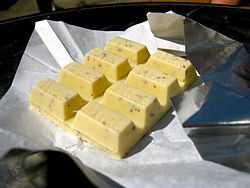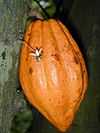White chocolate
| White chocolate | |
|---|---|
|
Bar of white chocolate containing pieces of rose petals | |
| Type | Chocolate |
| Main ingredients | Cocoa butter, sugar, milk solids, salts |
|
| |
White chocolate is a chocolate derivative. It commonly consists of cocoa butter, sugar and milk solids and is characterized by a pale yellow or ivory appearance. The melting point of cocoa butter, its primary cocoa bean component, is high enough to keep white chocolate solid at room temperature.
Composition
White chocolate is not chocolate in the strict sense as it does not contain cocoa solids, the primary nutritional constituent of chocolate liquor.[1] During the manufacturing process, the dark-colored solids of the cocoa bean are separated from its fatty content (as with milk, semi-sweet, and dark chocolate) but, unlike conventional chocolates, the cocoa solids are not later recombined. As a result, white chocolate contains only trace amounts of the stimulants theobromine and caffeine,[2] while lacking the antioxidant properties or many characterizing ingredients of chocolate, such as thiamine, riboflavin, and phenylethylamine.[3] Often, the cocoa butter is deodorized to remove its strong flavor.[4]
Some preparations known as confectioner's coating or summer coating may be confused with white chocolate, but are made from inexpensive solid or hydrogenated vegetable and animal fats, and are not at all derived from cocoa. These preparations may actually be white (in contrast to white chocolate's ivory shade[4]) and will lack cocoa butter's flavor.
Regulations
Regulations govern what may be marketed as "white chocolate": In the United States, since 2004, white chocolate must be (by weight) at least 20% cocoa butter, 14% total milk solids, and 3.5% milk fat, and no more than 55% sugar or other sweeteners.[5] Before this date, U.S. firms required temporary marketing permits to sell white chocolate. The European Union has adopted the same standards, except that there is no limit on sugar or sweeteners.[6]
History
In the 1930s, a white chocolate bar was launched in Europe by Swiss company Nestlé.[7]
In North America, Kuno Baedeker developed a white chocolate while working for the Merckens Chocolate Company in 1945.[8]
References
| Wikimedia Commons has media related to White chocolate. |
- ↑ http://www.livestrong.com/article/547875-can-people-who-are-allergic-to-chocolate-eat-white-chocolate/
- ↑ Kummer, Corby (21 December 1988). "America Is Going Sweet on White Chocolate". New York Times. Retrieved 3 November 2011.
- ↑ "Theobroma cacao L.". Retrieved 6 April 2011.
- ↑ 4.0 4.1 "The World's Best White Chocolate Page 3: Percent Cacao & Cocoa Butter". The Nibble. Lifestyle Direct. Retrieved 3 December 2009.
- ↑ "Requirements for Specific Standardized Cacao Products". Food and Drug Administration (United States). 1 April 2013. Retrieved 26 February 2014.
- ↑ "Directive 2000/36/EC of the European Parliament and of the Council of 23 June 2000 relating to cocoa and chocolate products intended for human consumption". Retrieved 27 October 2010.
- ↑ "The History Of White Chocolate". The Nibble. The World’s Best White Chocolate. April 1, 2008. Retrieved 2013-08-02.
- ↑ "Chocolate-Loving Couple Settled Here" (PDF). Lake Placid News (PDF) (Lake Placid, New York). March 19, 1987. p. 8. Retrieved 2013-08-02.
| ||||||||||||||||||||||||||||||||||||

